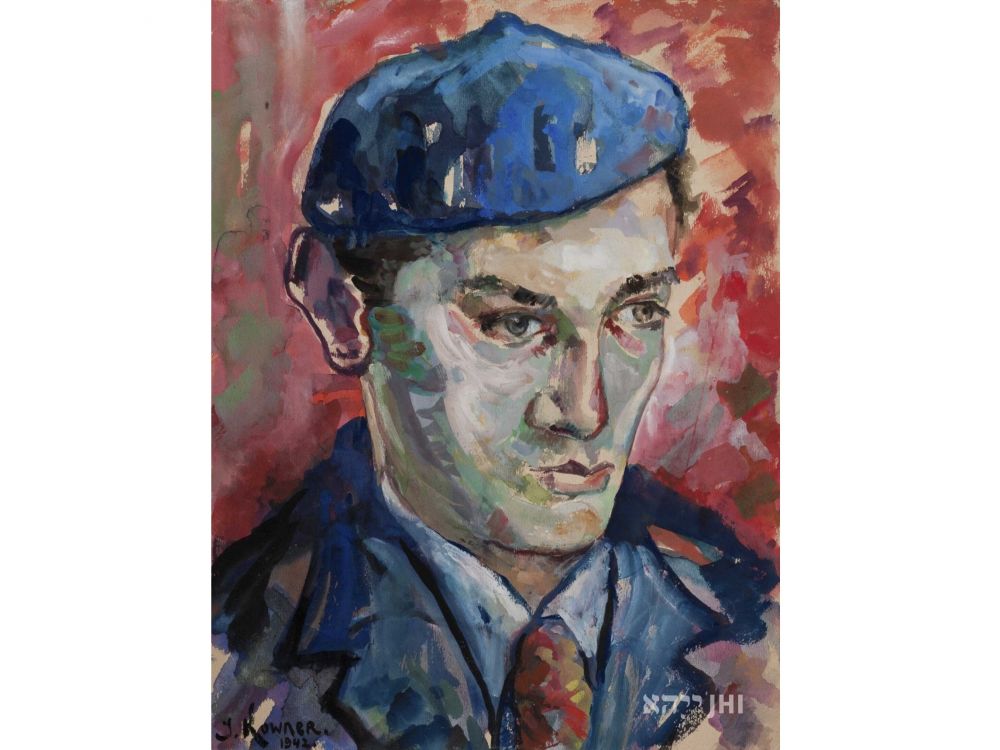- News
- Events
- Oneg Shabbat
- Collections
- Research
- Exhibitions
- Education
- Publishing Department
- Genealogy
- About the Institute
- Bookstore


Józef (Yitzhak) Kowner, Portrait of Mendel Grosman, Łódź Ghetto, 1942. JHI collection
Image descriptions:
David Friedmann, drawing from the album of the hat production plant, Łódź Ghetto, March 1943, JHI collection
Juliusz (Idel) Podeszwa, “Two little girls”, Łódź Ghetto, 1944, JHI collections
Correspondence. A letter from Józef Kowner, an artist and painter, to Mordechaj Chaim Rumkowski with a request to raise his monthly “subsidy”. Łódź Ghetto, JHI collection
Izrael Lejzerowicz, “Head of a young woman”, Łódź Ghetto, JHI collection
Public kitchen, March 1941. A group photo of employees. In the first row from the bottom, second woman to the right – Regina Rumkowska, the wife of Mordechaj Chaim Rumkowski. JHI collection
Five marks. Paper money from the Łódź Ghetto, JHI collection
Szymon Dratwa, “Jewish Tomb”. A poem from the Łódź Ghetto, JHI collection
Józef (Yitzhak) Kowner, “Portrait of a man in glasses”, Łódź Ghetto, JHI collection
Józef (Yitzhak) Kowner, “Cigarette seller”, Łódź Ghetto, JHI collection
The Łódź Ghetto in the collection of the Jewish Historical Institute
We encourage you to view and read the rich materials from the Łódź Ghetto belonging to the collection of the Jewish Historical Institute. Thanks to digitization we published them online in the digital repository of the Central Judaic Library:
All collections from the Łódź Ghetto
Sketchbook I – Izrael Lejzerowicz
Sketchbook II – Izrael Lejzerowicz
Album of the carpet factory from the Łódź Ghetto
Album of the hat production plant from the Łódź Ghetto
Paintings and drawings of Yitzhak (Józef) Kowner
Images by Mordechaj Chaim Rumkowski
Poems from the Łódź Ghetto (Polish language only)
A short history of the Łódź Ghetto
The Łódź Ghetto existed for almost 4.5 years – the Germans began resettlement in February 1940, and the gates were ultimately closed on April 30, 1940. As in other large cities, Poles (as well as many Germans in Łódź) had to leave the streets that were designated “closed district” – Jews had to take their place. Also just like in other cities, these were the poorest streets – the Old Town and the former village of Bałuty.
Almost 200,000 people were gathered together in the Łódź Ghetto when it reached its peak population in 1940-41. These were not only Polish Jews, but also exiles from Germany, Austria, the Czech Republic, the Netherlands, and Luxembourg – among them Gabriele and Valerie, Franz Kafka’s sisters. They were murdered, as were thousands of other Jews from the Łódź Ghetto, in the Kulmhof extermination camp (Chełmno nad Nerem). One of the most tragic events, Wielka Szpera (from German: Allgemeine Gehsperre – prohibition to leave homes, resulting in deportation), took place in September 1942. It was then that the Germans transported nearly 15,000 children up to the age of 10 and the elderly to the Kulmhof gas chambers.
The president of the Judenrat in Łódź was Mordechaj Chaim Rumkowski, who had an iron hand before his influence was taken away from him by his deputies who were more talented in dealing with the Germans, those like Aron Jakubowicz (who, unlike Rumkowski, was allowed by the Germans to survive). Rumkowski built the entire ghetto administration apparatus, printed his own currency, communicated with inhabitants by means of announcements and posed as a leader who came up with a plan to save the Jews through forced labour for the benefit of the German army. His plan partially worked – in forced labour plants, known as resorty, starving Jews from Łódź produced winter clothes for the German army, carpets, and hats. The working day lasted up to 10 hours, and en masse, children were working in the factories. In the ghetto there were no sewers, and the tenement houses adjacent to the wall on the “Aryan” side were demolished by the Germans, which prevented the possible emergence of a resistance movement.
In spring 1944 the Łódź Ghetto was inhabited by around 77,000 people. The Germans deported approximately 7,000 of these inhabitants to Auschwitz in July, and about 67,000 between August 7-29. The majority of these people were gassed at the beginning of September at the latest. Only around 1,400 people from the Order Command, who were tasked to search for valuables in the empty ghetto, lived to see the arrival of the Red Army. Overall, approximately 7,000 people survived the Łódź Ghetto in various labour camps. Among the survivors is Marian Turski, who spent almost two years in the Łódź Ghetto before being sent to Auschwitz in August 1944.